Share article:
COVID-19: How schools and educators can use SMS to communicate

When school returned in January, many educational providers such as schools, tertiary institutions and early childhood learning centres weren’t planning to dealt with the new reality of dealing with the social distancing requirements of COVID-19 and remote learning.
When mass pandemics happen, highly social environments like schools and workplaces, are often hotspots of outbreaks and require immediate closure to stem the spread. But the closure of schools creates its own issues for parents who could have obligations, such as being an essential worker, balancing working from home or adjusting to different working conditions.
A major issue, often gone unnoticed until a crisis strikes, is the ability for an organisation or group to enact immediate and widespread communications when required – and ensuring that the public authorities may be rigorously using as many methods they can but educators, without such resources or time, are unsure where to turn to first. That’s why we want to help them understand the power of SMS, especially during a major health situation like Coronavirus.
RELATED:Check out our industry page for more resources on SMS for education
How SMS can help educators stay on top of COVID-19
It was only the beginning of March when an elite Australian school announced that a senior staff member had tested positive for COVID-19. This male teacher had unwittingly been in contact with another person who had Coronavirus. Immediately, the principal had to send communications to all parents, and warn those families who had been exposed or around that teacher.
In less than a day or two, the school was forced to shut its doors. No one – parents, teachers, staff and principal – were prepared for any of this sudden closure, move to remote learning nor a potential infection to over 900 students.
For many schools who are already impacted across the world, Coronavirus heralds a situation that no one was prepared for. While we might not be able to recommend the best remote learning software or help teachers to adjust; we can advise he best way to tackle crisis communications between parents and staff, principals and students, and so on. Luckily, many education providers will not have to get their head around a new piece of software or device.
SMS is already highly utilised in most schools across the world. It is already used by many educators to enrich learning experiences, create better conversational messaging between parent-teacher parents and teachers and increase participation in important programs such as a compulsory state-wide secondary school vaccine program. As this 2019 vaccine study sought to find out, SMS reminders proved fruitful in increasing uptake of HPV vaccines in adolescents, and also enabled government policymakers to achieve national health goals.
With COVID-19 top of mind for most educators, here are some of the best ways you can use SMS to keep staff, parents and students aware and informed on movements around COVID-19.
1. School closure
According to UNESCO data, there have been school closures in over 192 countries, with nationwide closures impacting over 91% of the world’s student population. If your school is yet to close, maybe opening again, or is currently open for the children of essential workers; it is vital that you are able to notify parents or students of a potential closure due to a high-risk case or government directive.
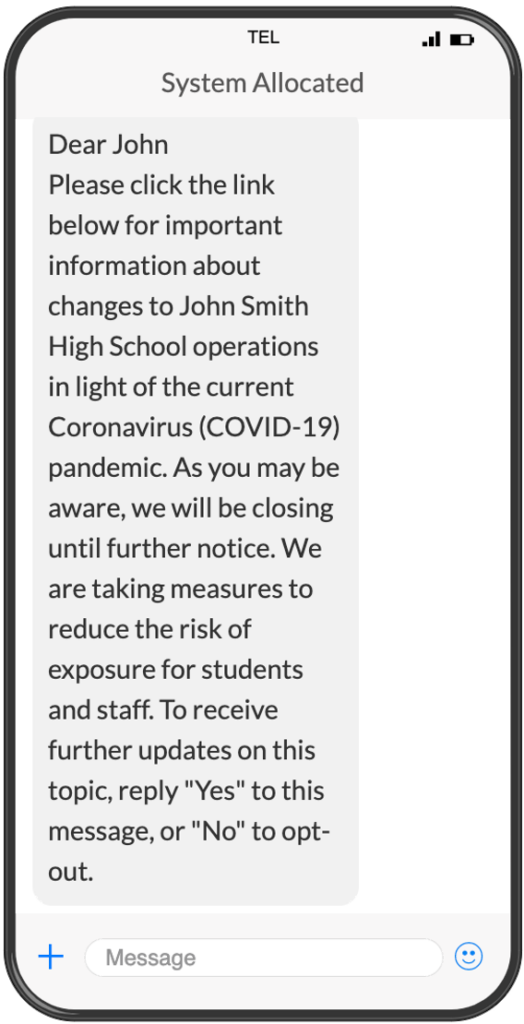
Top tip: Provide parents or students with an option to receive more information by utilising automations. At the end of this message template, notice how parents can respond with a “yes” or “no” to opt-out. Not only is this following through with local compliance and regulations, but it is also using automation to help consenting recipients receive more important COVID-19 updates from you.
DOWNLOAD: 2 x school closure templates – general closure and closure due to a confirmed COVID-19 case.
2. General statement or official letter to parents
Putting out a statement direct to students or parents and staff about your next steps as a provider is essential when curbing excessive uncertainty and concern. Many businesses like MessageMedia, and other industries are following suit when it comes to informing customers and the like on how they are handling COVID-19.
Rankin County School District in Massachusetts, USA sets out in a long letter to parents about their movement to distance learning, future grading, grade promotion and retention guidelines, as well as when and if school may resume as normal.
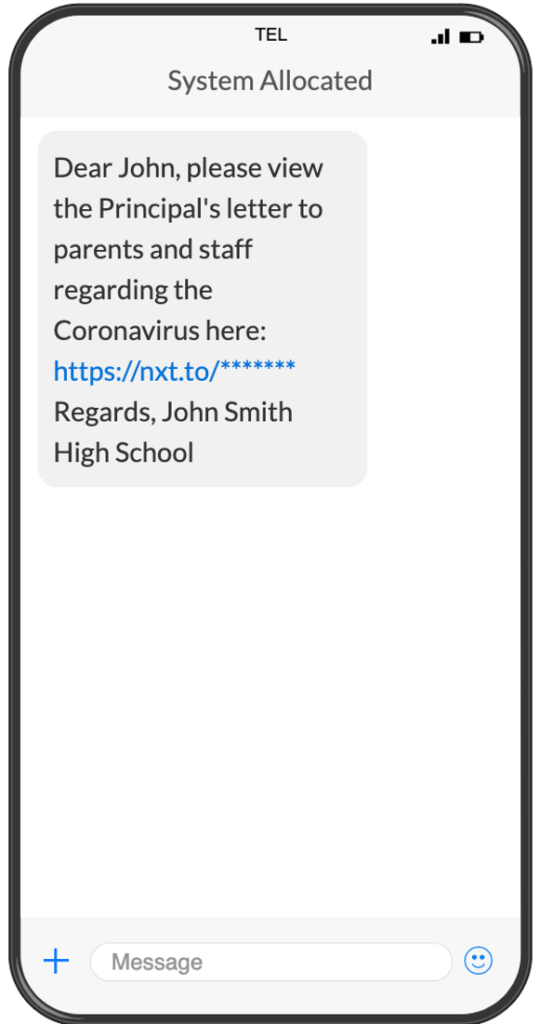
TOP TIP: SMS messages are 160 characters, so it’s important to keep them short and to ration your words. Use a short trackable link which helps abbreviate overly long URLs. You can find these online, or use a similar function enabled by your messaging provider, such as MessageMedia’s.
While statements or letters are often hosted these days on school websites, SMS can be used to direct parents or students to where this information is being kept via a simple, easy-to-click URL.
DOWNLOAD:General statement messaging template here.
3. Remote learning/distance learning
The future of education will change forever given the current uptake in remote learning to protect students from COVID-19. UK’s Department for Education, like many others around the world, has already put together a hub for free online resources for home education.
Primary schools such as Fulbourn Primary in Cambridge have supplied parents with a list of online education resources, while many universities have put together support hubs for students.
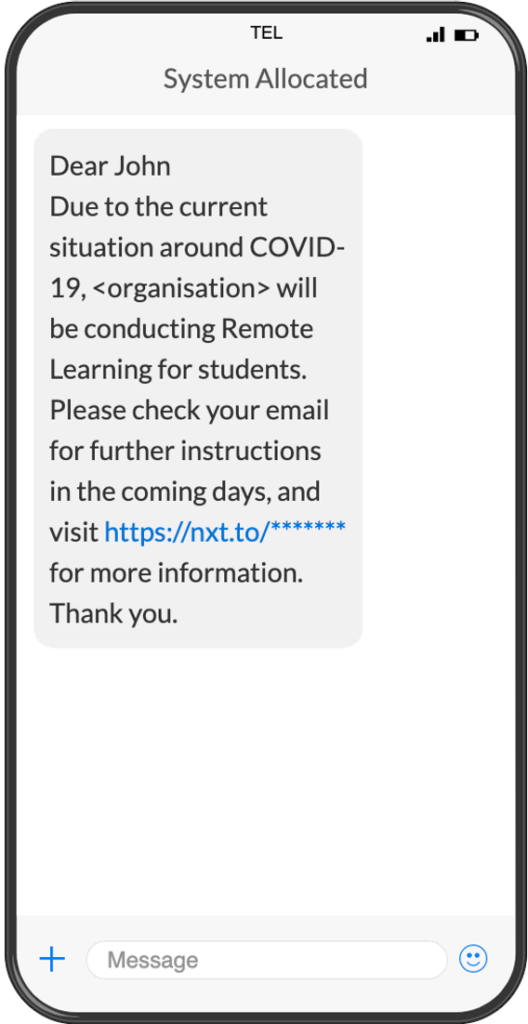
TOP TIP: You do not have to include all the information about the next steps for remote learning in your one SMS. It’s best to announce the move towards remote learning. Utilising what we learned from the general statement template, link parents and students to an external location on your school’s website with a resource guide like we’ve seen in the UK examples above.
It’s essential that you let parents and students know, as soon as possible, that your school or education provider is moving to distance learning. Keep in mind, it will require more detailed steps, time and resources for parents and the students to adjust to new ways of learning.
While many more mature students are already used to listening to tertiary lectures online or learning from Youtube tutorials; younger students, parents, carers and those with learning disabilities will need extra help to prepare for such a move.
DOWNLOAD:Remote learning messaging template.
4. Returning to campus
While this may not be on the horizon for some of us, this may be on the cards for others. In Australia, Federal Minister for Education Dan Tehan has ordered independent schools to re-open after closing for an early school holidays. In addition, he is allowing parents to choose if they want schools to provide face-to-face education to frontline workers who are unable to do their jobs and take care of kids at home.
Even if your school is closed, it is still recommended that providers get ahead of their communications and have templates scheduled and at-the-ready for when re-openings commence, and restrictions are lifted.
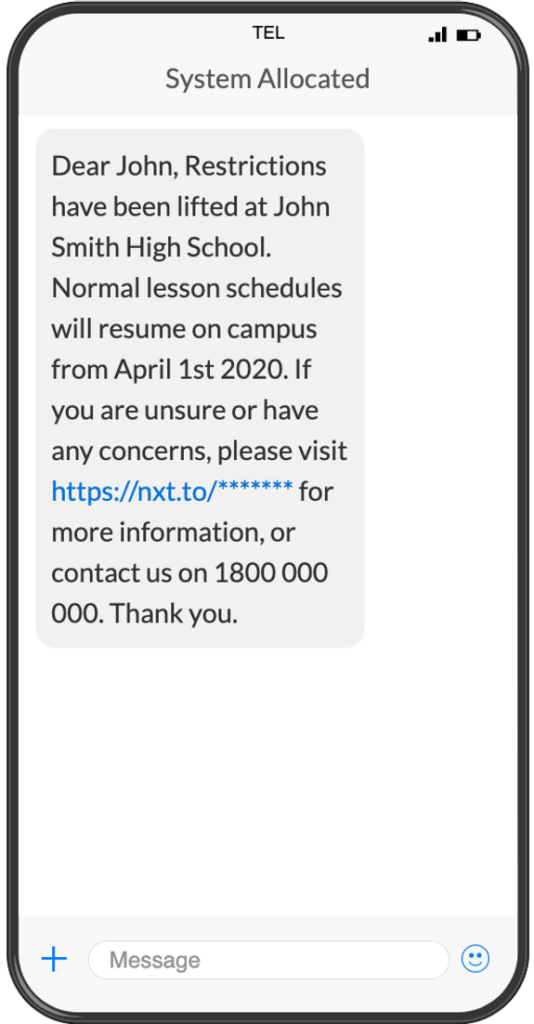
TOP TIP: Make sure you personalise all templates with a first name identifier, and check that you have the correct date and the inclusion of a short trackable link, such as with the general statement. Additionally, make sure that your message ends with a way for stakeholders to contact you if they have any concerns about returning to campus.
Using this template will make it easier for schools to communicate to a wide range of stakeholders, not just parents or students when campuses re-open and the normal schedule begins again.
DOWNLOAD:Return to campus messaging template
5. Provide information and updates
With new changes to how the government is handling COVID-19 on a daily basis, it’s important to keep parents, students and staff abreast of these fluctuations and how they will be locally implemented within schools.
In the UK, schools have struggled to deal with the slow response and lack of support from the Department for Education, and have had to manage the implementation of safe COVID-19 changes themselves. Over 124,000 schools across the US’50 states have closed, and educators continue to beg the federal government for guidance for what will come next.
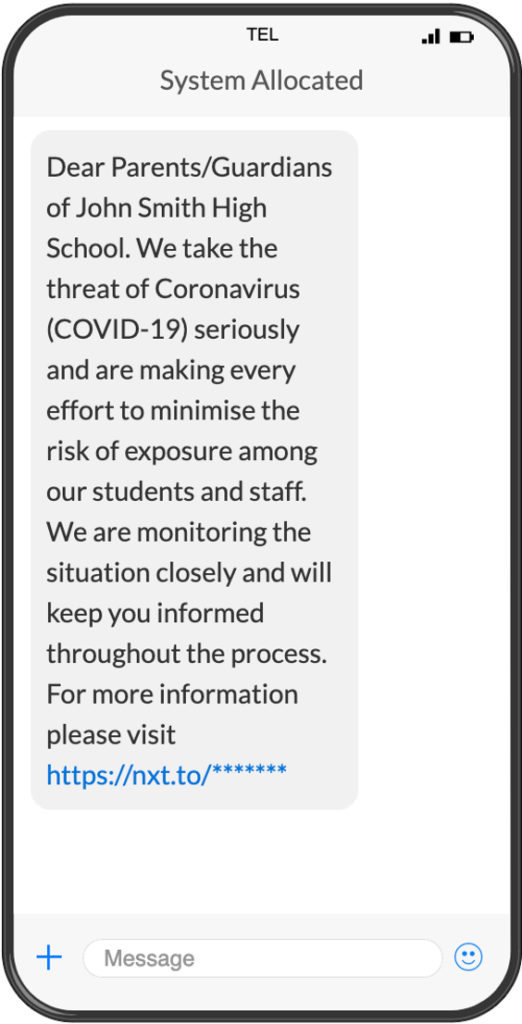
TOP TIP: Want to see update automations in actions? Try our free COVID-19 support line. Text ‘SUPPORT’ to +61463278682 and follow the prompts to get messaging templates and guides for using SMS during COVID-19.
Ensuring clear communication channels and constant daily updates is an easy way for schools to stay in contact with parents and children. We touched on before about SMS opt-ins and opt-outs, and encourage providers to set up automations that allow recipients to consent to SMS-driven updates. This information can be contained within the SMS, or better yet as we saw in the general statement example, linked out to a separate location, microsite or document.
DOWNLOAD:Provide information messaging template here.
6. School remaining open
For those who have been able to stay open, this messaging template will help answer the many concerns being put to you by students on campus or by anxious parents, wanting to know when or if shutdowns will happen.
In Australia, it took a few weeks before schools were mandated to shut, and many providers were putting out communications to parents that they were staying open in the meantime. As reiterated earlier, changes are happening daily so keeping learners and their families reassured that schools are remaining open may be all you can put out for now.
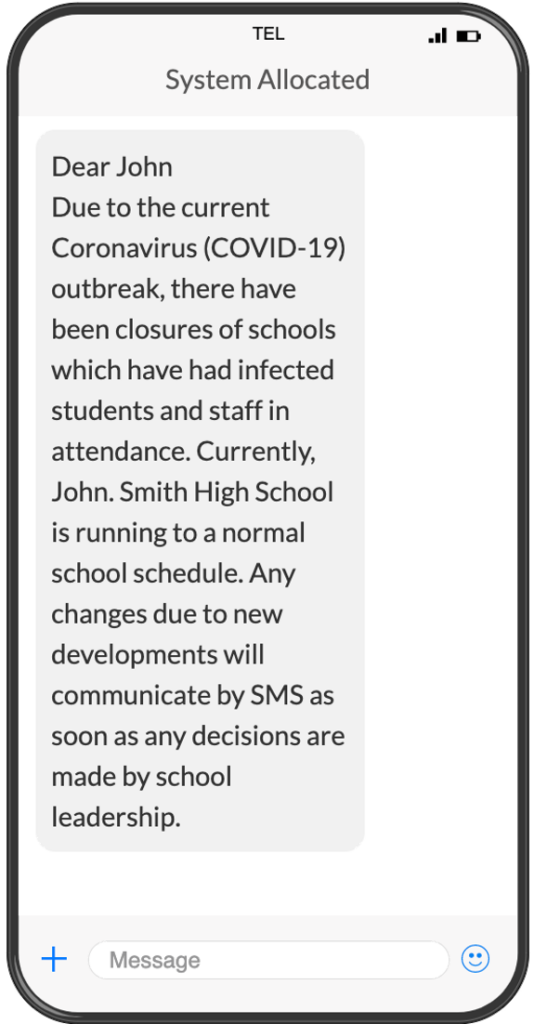
TOP TIP: It’s not about just staying open, but reassuring parents and students that normal scheduling will also be followed including class times, tests or meetings. If you have already moved to remote learning or distance learning, a similar template can be used to ensure that timetabling will be staying the same such as requiring students to be available at the same hours they would be if they were at school.
DOWNLOAD: School remaining open messaging template here.
How your school can get started with SMS now
There is no doubt that this is a challenging time for many educators across the globe. For many schools, there is still constant uncertainty as to what their future and the future of learning for their students will be.
While governments and states continue to grapple with what may be considered the biggest pandemic of our lifetimes, schools will continue to struggle to find communication solutions that will best resolve COVID-19 issues.
There’s never been a better time to use what has proved to be one of the most universal and familiar technological methods of communication since the early 90s. Help keep students, staff, parents and community members alert, informed and engaged about COVID-19 by using SMS now.
Here’s how to get started:
- Watch our webinar or read our in-depth 101 guide on preparing your school for sending out urgent SMS
- Read our case study on how we helped education provider EdSmart get the right message at the right time to school parents
- Browse our special COVID-19 (Coronavirus) resource hub that comes with plenty of guides, messaging templates and other support articles to help you get going.
- See how else SMS has helped education providers in the past.
- Get in contact with our team now if you have any questions, or want to get started using MessageMedia’s SMS platform.
